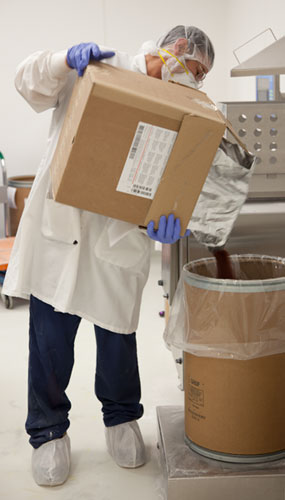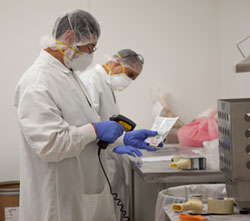 By David Baker
By David BakerTo average people, grapeseed extract is just that—anything pulled from the seeds of grapes.
To scientists in the labs of USANA Health Sciences, grapeseed extract is a complex mixture of organic compounds containing 80–90 percent phenols (also known as proanthocyanidins) and 10–15 percent monomer content.
 At least that’s what good grapeseed extract is. If you’ve
spent years testing different products, like Dr. Mark Brown, USANA’s director of
product development, you know the importance of knowing the good grapeseed
extract from the bad.
At least that’s what good grapeseed extract is. If you’ve
spent years testing different products, like Dr. Mark Brown, USANA’s director of
product development, you know the importance of knowing the good grapeseed
extract from the bad.In his time with USANA, Brown has seen the bad—samples from prospective suppliers that contain less than five percent phenols and no monomers.
“It really makes you wonder, ‘What is grapeseed extract from these people?’” said Brown, an organic chemist by trade. “Usually, what you pay for is what you get.”
The material USANA purchases is on the high end of the price spectrum, but Brown says it’s well worth it because the extract contains greater than 80 percent phenols and has monomer content of about 10 or 15 percent. USANA has been using the product for almost 20 years now, with great results.
“It would be tempting to change and save some money,” Brown said. “But we just don’t work like that.”
The way USANA does work is going above and beyond to make sure the products that bear the company name are the highest-quality nutritional supplements on the market. That starts with purchasing the very best raw materials. But it also means testing every lot of those materials to make sure they’re pure, potent, and worthy of Dr. Wentz’ signature.
 Raw material testing starts when shipments enter the
building. Quality assurance inspectors check paperwork and perform a visual
inspection for shipping damage. From there, a gowned employee, working in a
clean room with HEPA filtered air, uses written protocol to collect a
representative sample to send to the lab.
Raw material testing starts when shipments enter the
building. Quality assurance inspectors check paperwork and perform a visual
inspection for shipping damage. From there, a gowned employee, working in a
clean room with HEPA filtered air, uses written protocol to collect a
representative sample to send to the lab. Each sample goes through testing for microbiological contamination, like yeast, mold, and bacteria. There are also identification tests to make sure the vitamin B12 you ordered is, in fact, vitamin B12. Potency and physical testing is also done.
Most ingredients then go through specific testing to ensure they meet United States Pharmacopeia (USP) standards for things like purity, solubility, and density. Depending on the product and active ingredient, more tests for pesticides or heavy metals may be done.
 “Most people will buy a
material, and it will come with a piece of paper that’s called a Certificate of
Analysis,” said Dr. John Cuomo, USANA’s executive director of research and
development. “They’ll file that Certificate of Analysis away and say, ‘This is
what we use. Here’s a piece of paper.’
“Most people will buy a
material, and it will come with a piece of paper that’s called a Certificate of
Analysis,” said Dr. John Cuomo, USANA’s executive director of research and
development. “They’ll file that Certificate of Analysis away and say, ‘This is
what we use. Here’s a piece of paper.’ | “It would be tempting to change and save some money. But we just don’t work like that.” |
“We’ve found that sometime you get a piece of paper from companies that actually makes sense, and sometimes they’re just a piece of paper—and worth about as much as a piece of paper.”
The Food and Drug Administration (FDA) guidelines for nutritional supplements hold the manufacturer of a finished product responsible for assuring the material used was the correct material. But that doesn’t mean manufacturers are required to do full testing on every lot of raw materials.
USANA does. Every lot of every raw material is tested. This isn’t the industry standard, but it’s the USANA standard.
We’re proud to bring you the freshest content on the web! Follow USANA, like our USANA Facebook page and enjoy the latest videos on the official USANA YouTube channel.
Learn how USANA is making the world a better place.
No comments:
Post a Comment